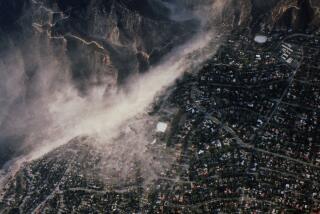We’re Not Gaining on Infrastructure Crisis, It’s Gaining Ominously on Us : Transportation: Deteriorating bridges and highways can no longer be ignored. Snail’s-pace driving and the quake prove that.
Perhaps it requires a 7.1-magnitude earthquake to shake Americans into paying attention to our decaying transportation system.
Just a few years ago, one of the most popular buzzwords in Washington was infrastructure. Capitol Hill and the press corps were awash with study after study illustrating the deteriorating state of our bridges, highways and railroads.
In a nation where swift and safe transportation is essential, those reports added up to trouble, with a capital T. Unfortunately, solving the great infrastructure crisis added up to dollars, with a capital D. And so the President, Congress and legislatures alike swept the crisis under the rug.
But the Northern California quake changes the politics, and the reality, of addressing our infrastructure dilemma:
* According to the Federal Highway Administration, more than 132,000, or 23%, of America’s bridges are structurally unsound; one fails every two days.
* Two-thirds of the interstate highway system is in substandard condition.
* The Army Corps of Engineers has concluded that there are 3,000 unsafe dams in populated areas, not a comforting thought to those who live in earthquake-prone regions.
Nowhere is a quality transportation service more essential to productivity and competitiveness than in California, which has experienced a jobs-and-population explosion in the 1980s. Between 1964 and 1984, the state highway system grew by 29%. But over the past two decades, traffic has grown five times faster than capacity; in another 20 years, there will be 9 million more Californians driving 41% more cars on 50,000 additional miles of highway.
No one has seriously planned for the statewide traffic jam that looms. Indeed, those studying the problem note that freeway congestion will grow five times worse by the year 2010, reflecting not only more cars on the road, but also longer commutes for people forced to buy in distant, but more affordable, suburbs. As a result, the average sloth-like speed of 35 m.p.h. will slow to a snail’s-pace 19 m.p.h.
This isn’t to say there are no plans to spend money for transportation and infrastructure. But most of the billions are intended to keep us at current, unsatisfactory levels. For example, a 1988 survey predicted that Southern California would have to spend $110 billion over the next 20 years to build a freeway and transit system that would permit residents to travel as easily as they could in 1984. Nationwide, we must spend $65 billion annually just to stay even, according to the National Council on Public Works.
There is speculation that safety improvements on the collapsed Interstate 880 freeway were deferred because of inadequate state funds, a direct consequence of the fiscal myopia celebrated by California politicians and voters alike over the past decade. Now, in the wake of a transportation crisis generated by the earthquake, legislative leaders are discussing a huge gasoline tax increase to finance repair of the state’s quake-damaged infrastructure.
But roads and bridges damaged by the quake are a drop in the bucket compared to the overall need in California, let alone the entire country. And as with so many of our deferred priorities, we are facing the question that won’t go away: Who pays?
If anything, the quake response will mislead Californians about how difficult it will be to address transportation improvements so critical to the state’s safety and economic security. Congress will waive restrictions on how much California can receive in emergency federal transportation aid and not require the typical matching monies from state and local governments. But future federal support will demand substantial local shares--and that means taxes and user fees.
Now, while the terrible tragedy of Interstate 880 is fresh in our minds, is the time to begin serious planning, including discussion of how to fairly finance improvements and expansions to our infrastructure. We need an infrastructure improvement policy in California and throughout the nation that doesn’t depend on the next quake to generate public support.
More to Read
Sign up for Essential California
The most important California stories and recommendations in your inbox every morning.
You may occasionally receive promotional content from the Los Angeles Times.










